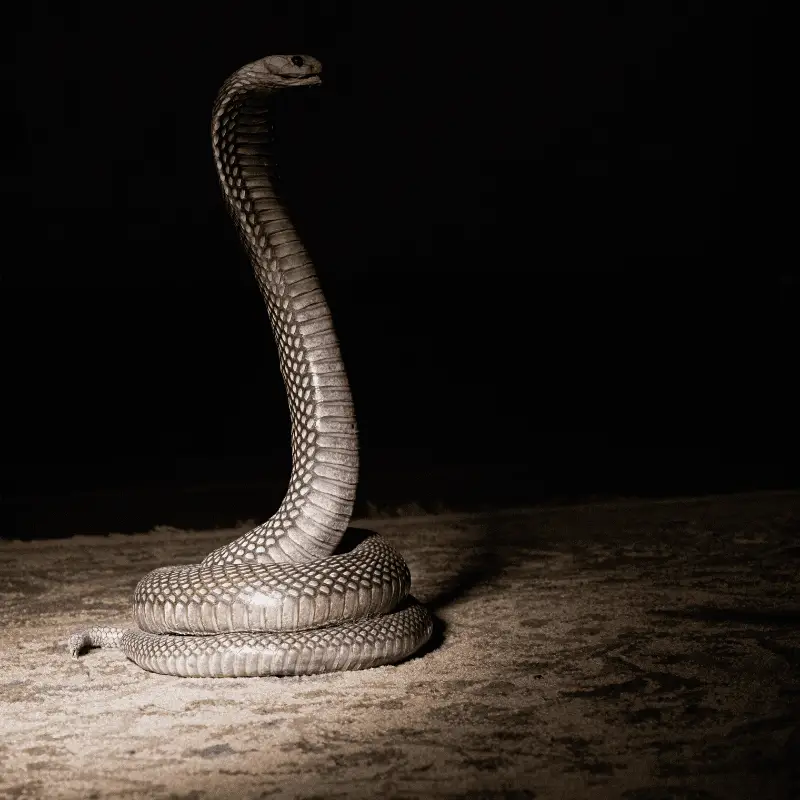Snakes are perhaps one of the most feared animals on earth. For most people, the size of the snake does not matter. They do not even want to know whether the snake is venomous or non-venomous. You must know, some snakes catch their prey during the daytime. That raises another question, Does the snake see during the night?
The nocturnal snake species have evolved so that they can see clearly in the dark. Even though the snakes’ eyes are relatively small compared to their body, they are very efficient in finding prey in the dark and catching them. Most of the snakes love to dwell in darker places. They possess infrared heat-sensitive vision, which makes them exceptional night-time hunters.
How can Snakes see at night?
Thanks to a protein channel in their eyes, the snakes can see in the dark. These protein channels get activated by the heat that emits from the bodies of other living beings. Snakes, like pythons, vipers and boas, have holes in their heads known as pit organs. A membrane in the pit organ helps the snakes detect the infrared radiation that any warm bodies emit. The snakes can detect the heat of the bodies from about a meter away. At night, the pit organs help the snakes to see the image of their prey or predators, just like the way we can see images in an infrared camera. This extra sense makes the snakes one of the deadliest predators in the dark.
Snakes do not use their eyes to see in dark
When it comes to vision, snakes have a huge problem; most snake species’ eyesight is weak. They cannot even see clearly during the daytime, which makes it almost impossible for them to catch their prey in the pitch darkness of the night.
The funny thing is, most of these snakes do not even use their eyes to see.
Researchers have studied the snakes ‘ movements when their eyes are covered with patches to assess whether these snakes use their eyes to catch the prey in the darkness. The studies showed that the snakes could successfully catch their prey and kill it even blindfolded.
Even though the researchers have proved that the snakes use their pit organs for sensing their prey, they still do not know exactly how the snakes detect and turn the infrared signals into nerve impulses. Over the years, this has been a topic of sharp debate among scientists. Here are some of the perspectives of scientists.
Photochemical Process
One of the celebrated candidates of this debate is the photochemical process. According to the researchers, the snakes’ eyes can see the electromagnetic radiations known as visible light, like photons. These photons activate the receptor cells in their eyes, which, in turn, converts this energy into a biochemical signal. The nervous system of the snakes sends these biochemical signals into their brains to create the image.
For example, some fishes can see into the electromagnetic spectrum by using the infrared wavelength. The researchers believed that the snakes also see in the dark using the same method.
Molecular Level
American researchers have recently demonstrated how the molecular system helps snakes to visualise infrared images. The study published in the Nature journal showed that the snakes’ pit organ contains an ion channel known as TRPA1.
It is one of the infrared receptors which can recognise infrared radiations as heat instead of light. It supports the long-lasting theory regarding the pit organ’s functions that behavioural ecologists propagate for a long time.
This receptor is also found inside the head of mammals. However, in the case of mammals, the TRPA1 channels, also recognised as the wasabi receptors, help identify the pungent irritants of mustard plants and other similar resources.
The pit organ bypasses the eyes
The pit organ helps the snakes to get infrared images of the predators and prey in darkness. However, it does not allow them to see. The pit organ is an essential part of the somatosensory system of snakes.
That means the pit organ helps to detect temperature, touch and pain. It does not connect with the snakes’ eyes, and thus, it does not gain any signal from them. That again confirms that the snakes see the infrared images by finding out the heat resources and not the light photons.
The infrared radiation stimulates the pit membrane. When the heat reaches a certain level, the TRPA1 channel gets opened. It allows the ions to directly flow to the nerve cells, which creates the energy signals.
The membrane of the pit organ hangs on a boney hollow chamber. That enhances the ability of the snakes to detect different temperature variations among the living and non-living elements. It helps it to lose heat very fast.
According to the researchers, the TRPA1 channel gets open if the temperature is more than 28 degrees Celsius. That is why the snakes can detect smaller prey like squirrels and mice from about a meter away.
Do snakes sleep?
Yes, snakes do sleep. Snakes are nocturnal, meaning they stay active during the night. That does not mean they don’t sleep. Even though the snakes do not have any eyelids, most of them sleep a lot. They also love dark places that can give them a cocoon-like feeling.
Conclusion
Snakes, in general, do not have a super-sharp vision. Most of them cannot see clearly, even in the bright daylight. They can only figure out the outlines of the objects and animals. However, most of them can navigate well at night, thanks to their infrared vision. Even though it is not the textbook way of seeing their prey, it helps the snakes to move around, flee from the predators and catch the prey.

